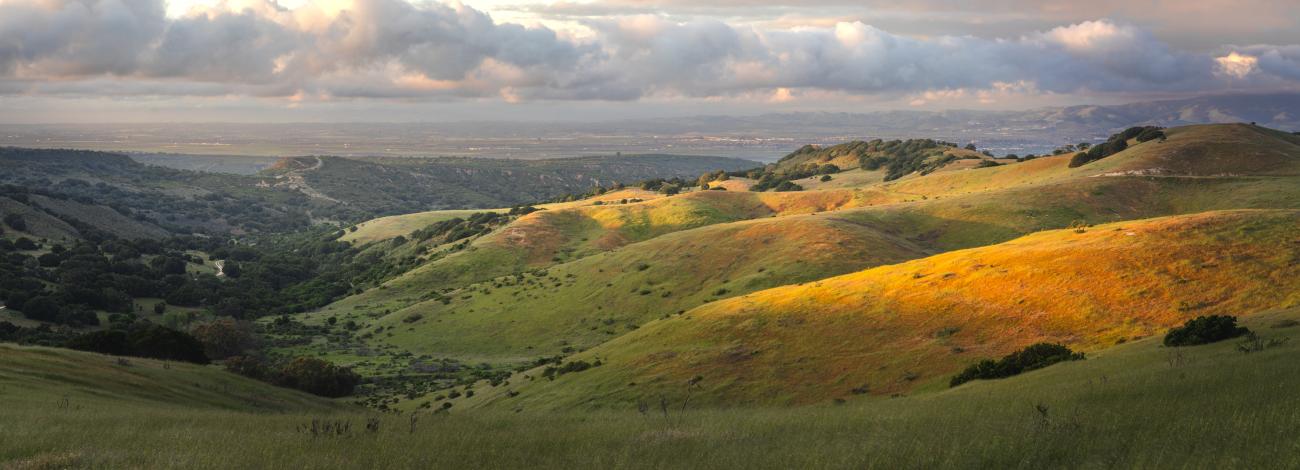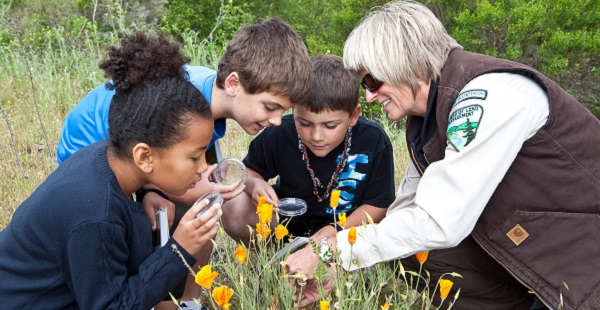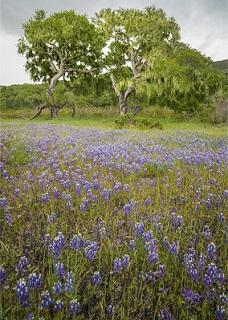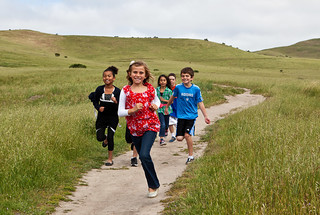
Fort Ord National Monument
A rich history, diverse habitat and bountiful recreation opportunities await you at the Fort Ord National Monument. Another coastal gem with more than 86 miles of trails provides opportunities to hike, bike or ride your horse through rolling hills, pockets of chaparral and oak woodlands. You will see a huge diversity of plant life and animals in habitats that include streamside corridors, grasslands, maritime chaparral, oak woodlands and seasonal pools.
Fort Ord is also cherished for its link to the heroism and dedication of men and women who served our nation and fought in the major conflicts of the 20th century. This area remains undeveloped thanks to its role as a U.S. Army facility from 1917-1994. During the Vietnam War, it served as a leading training center and deployment staging ground. As many as 1.5 million American troops trained at Fort Ord.
It’s all in the heart of the Monterey area, with its many attractions, abundant natural resources and beautiful access to the California Coast and Salinas Valley.
-
Know Before You Go
-

Public Safety Phone Numbers
Emergencies: 911
Non-Emergency Law Enforcement issues or assistance: 831-242-7851
Please obey all posted restrictions. It is your responsibility to know the rules for your own safety and for health of special habitats, plants, and animals.
All animals must be on a leash and under the owner/handler's physical control within developed recreation sites at all times: Dogs and stock must be on a leash/lead rope that is no more than six feet long and is held or otherwise attached to the owner/handler while in parking lots, at trailheads, along driveways, or anywhere else that signing indicates that pets must be leashed.
Observe barricades and signs marking unsafe, sensitive, or restricted areas: Motor vehicles found in closed areas may be towed or impounded at owner's expense.
Non-street legal motor vehicles including motorcycles are never allowed on Fort Ord National Monument: This restriction is required to reduce erosion and protect sensitive habitats and species.
Use is non-motorized on authorized trails only: Authorized trails are marked with brown or green fiberglass trail markers. Staying on these trails will keep you off fragile plant and animal habitats, out of poison oak, and out of dangerous unexploded ordnance areas.
E-Bike Rules (e-bikes are still considered a class of off-road motorized vehicle): At Fort Ord National Monument, motorized vehicles and off-road vehicles are prohibited from the 86 miles of the Monument's non-motorized roads and trails without a special permit. In November of 2020, the BLM issued an e-bike rule, which 1) amended the BLM’s off-road vehicle regulations to include a special class for e-bikes at 43 CFR 8340.0-5(j) and 2) created an authority by which authorized officers may allow e-bike use on trails where motorized vehicles are otherwise prohibited. The BLM is evaluating e-bike impacts on the Monument roads and trails, and anticipates revising the road/trail use designations under CFR 8340 to better align with the differences of e-bike impacts with those of motorcycles, ATV's and UTV's. Once completed, the BLM will sign the roads and trails where certain classes of e-bikes would be allowed and prohibited, and those restrictions will be enforced.
Travel at Safe Speeds When Passing: Most trails on the National Monument are open to hikers, cyclists, and equestrians. When approaching other visitors on the trails, cyclists must yield the path to pedestrians and equestrians. Cyclists should never pass other oncoming visitors faster than 5 mph on single-track trails.
Use of a closed trail is never allowed: Red trail markers indicate a closed trail. Exception are granted with written permission by an authorized BLM officer. Trails that have no signs or are not shown on BLM's recreation trail map are also closed.
Use of Metal Detectors and/or removal of artifacts is not allowed on the National Monument: Hazardous military munitions still may be present near some of the public use areas. Non-hazardous military relics are objects and values of the National Monument and may not be removed as required under the Monument Proclamation.
Do not bring weapons: Possession, use and/or discharge of any kind of weapon is never allowed; this includes paintball guns.
Fireworks are never allowed: Even small open flames or fires have the possibility of escaping and becoming large.
Littering and dumping is illegal.
Wood cutting or collection is prohibited: Many animals use downed wood for nesting, sleeping or feeding.
Public use is allowed from dawn to dusk.
These closures and restrictions are under the authority of 43 CFR 8341.2. Persons violating these closures and restrictions shall be subject to the penalties provided in 43 DFR 8360.0-7 and 8340.0-7, including a fine not to exceed $100,000 and/or imprisonment not to exceed 12 months.
-
Friends and Partners
-

Fort Ord National Monument relies on Partnerships to improve the health of the land and quality of the recreational experience.
The Watershed Institue at California State University Monterey Bay has been a partner with the BLM at Fort Ord for well over a decade. Working closely with their Return of the Natives program (RON), hundreds of acres of former military training lands with non-native vegetation has successfully been restored into ecologically stable sites with native plants.
An important Partner with Fort Ord National Monument is the U.S. Army's Fort Ord Base Realignment and Closure Team (BRAC). BRAC at Fort Ord currently manages half of the Monument and works with the BLM on weed abatement, habitat restoration, and the Herculean task of removing Munitions and Explosives of Concern from future lands on the Monument that will be accessible to the public.
FORT Friends is an local non-profit organization that supports the Fort Ord National Monument and occasionally cosponsors BLM celebratory events, volunteer efforts, and other monument-wide initiatives. This organization focuses primarily on recreational trail opportunities on the former Fort Ord and has been a strong partner with the BLM since the monument was designated in 2012.
The BLM has worked with the Monterey Off-Road Cycling Association (MORCA) on the national monument for over 10 years. Although MORCA has a county-wide cycling interest, a significant amount of partnering occurs on Fort Ord in regards to trail stewardship. MORCA sponsors monthly trail volunteering opportunities and has constructed several new trail segment as planned by the BLM.
Along with the contributions of BLM Volunteers, Fort Ord National Monument continues to be a successful blend of partnerships.
-
People and Culture
-

Journeys Across Land and Time
Hiking, jogging, biking, horseback riding
Journey through the Fort Ord National Monument and you may encounter traces of others who traveled here many years ago.Native Americans hunt and collect
Before there was Fort Ord, there were Costanoan Indians. Archaeological sites show that Native Americans lived in the area for thousands of years. They used this area for hunting and gathering. Today their descendants still use Fort Ord National Monument for traditional activities.1700s The Spanish explorer
Juan Bautista de Anza sought to find an overland passage to Alta California. The Historic Trail crosses the national monument between Creekside Terrace and Badger Hills trailheads. The expedition eventually led to the European settlement of San Francisco.1800s The Ranchers ride
During the 1800s, large Spanish and Mexican land grants became the property of small ranching families. Mexican land grants “El Toro” and “El Chamisal” were used for ranching and today constitute most of the national monument.1900s The Army marches
In 1917 the U.S. Army created the nearly 16,000 acre Gigling Reservation as an artillery impact area to train soldiers stationed at the U.S. Army Presidio of Monterey.Today, your journey
The BLM manages the Fort Ord National Monument in a manner that protects natural values, honors the military and cultural heritage of the landscape and offers high-quality, non-motorized recreation opportunities. Your cooperation will help ensure that 35 species of rare and endangered animals and plants that make this place their home are protected for generations to come. -
Wildlife and Plants
-

In the heart of California's Central Coast, the Fort Ord National Monument encompasses a sweeping landscape of vivid beauty and rich natural diversity. One of the few remaining expanses of large, contiguous open space in the increasingly developed Monterey Bay and Salinas Valley area, this area is a rolling landscape of maritime chaparral, oak woodland, grassland, vernal pool and wet meadow. Originating in the Pleistocene Epoch, ancient dunes provide the foundation for this landscape's unique array of plant and wildlife communities.
The diversity of vegetation helps ensure a long-season of annual wildflowers as well as showy floral blooms on chaparral shrubs. In the late winter and early spring, monument visitors are treated with colorful displays of baby blue-eyes, ceanothus blue blossom, Hickman's popcorn flower, buttercups, lupine, goldfields and sunflowers. In the summer and fall visitors see blooms of sticky monkey flower, nightshade, chaparral current and California golden rod. There are many rare plants at Fort Ord including the federally protected Contra Costa goldfields and Monterey spineflower.
Unique habitats support a tremendous diversity of mammals, birds, reptiles and amphibians. Many visitors to the national monument get a chance to see bobcats, coyotes, black-tailed deer, rabbits and ground squirrels. Mountain lions, California badgers, red fox and Monterey ornate shrews also share this coastal treasure. The skies are patrolled by vultures, red-tailed hawks, and kestrels while California quail, turkeys and road runners often scamper about on the ground. In the spring, don't be surprised to see California king-snakes, gopher snakes, garter snakes and occasionally rattlesnakes sunning themselves on the sun-baked roads. In the winter, you might see the federally protected California tiger salamander on the move towards vernal pools as they fill with water.
-
Veterans
-

Fort Ord National Monument Veterans
As a former Army base, Fort Ord was a training ground for many military personnel. People once stationed at Fort Ord and the families of service members often visit Fort Ord National Monument to revisit where they once trained (note: the National Monument encompasses many former maneuver and range areas, but no former Army barracks and/or training buildings). Veterans and their families sometimes have questions about obtaining service records or the Central Coast Veterans Cemetery. Please contact our partners for more information about accessing records or about the Central Coast Veterans Cemetery. We welcome anyone who is interested in exploring Fort Ord to check out the trails on the monument.
Military Records
The Fort Ord National Monument does not have access or retain any military personnel records. We encourage people who are seeking these records to contact the National Personnel Records Center or the Monterey County Military and Veterans Affairs Office.
For records, please contact:
National Personnel Records Center – National Archives and Administration
314-801-0800
866-272-6272
www. archives.gov/st-louisMonterey County Military and Veterans Affairs Office
1200 Aguajito Road, Suite 003
Monterey, CA 93940
831-647-7613Fort Ord National Monument Partner Central Coast Veterans Cemetery
The Central Coast Veterans Cemetery (CCCVC) is a neighboring partner of the Fort Ord National Monument. Located in Monterey County, within the city of Seaside, the Central Coast Veterans Cemetery is the second California Veterans Cemetery developed and constructed in cooperation with the United States Department of Veterans Affairs, Veterans Cemetery Grants Program. The CCCVC is still under construction; however, the first phase of the cemetery opened on October 11, 2016.
To find out more about the cemetery, please contact our partners at:
The California Central Coast Veterans Cemetery
831-393-9371
Their Office is located at the veterans cemeteryMonterey County Military and Veterans Affairs Office
1200 Aguajito Road, Suite 003
Monterey, CA 93940
831-647-7631Office hours vary, please call before dropping by.
-
Military Records
-
Fort Ord National Monument Military Records
As a former Army base, Fort Ord was home to many Army personnel. People once stationed at Fort Ord and family of service members often seek military records and to explore the grounds. The Fort Ord National Monument does not have access or retain any military personnel records. We encourage people who are seeking these records to contact the National Personnel Records Center or the Monterey County Military and Veterans Affairs Office. We welcome anyone who is interested in exploring Fort Ord to check out the trails on the monument.
For records, please contact:
National Personnel Records Center – National Archives and Administration
314-801-0800
866-272-6272
www. archives.gov/st-louisMonterey County Military and Veterans Affairs Office
1200 Aguajito Road, Suite 003
Monterey, CA 93940
831-647-7613
Office hours vary, please call before dropping by.


